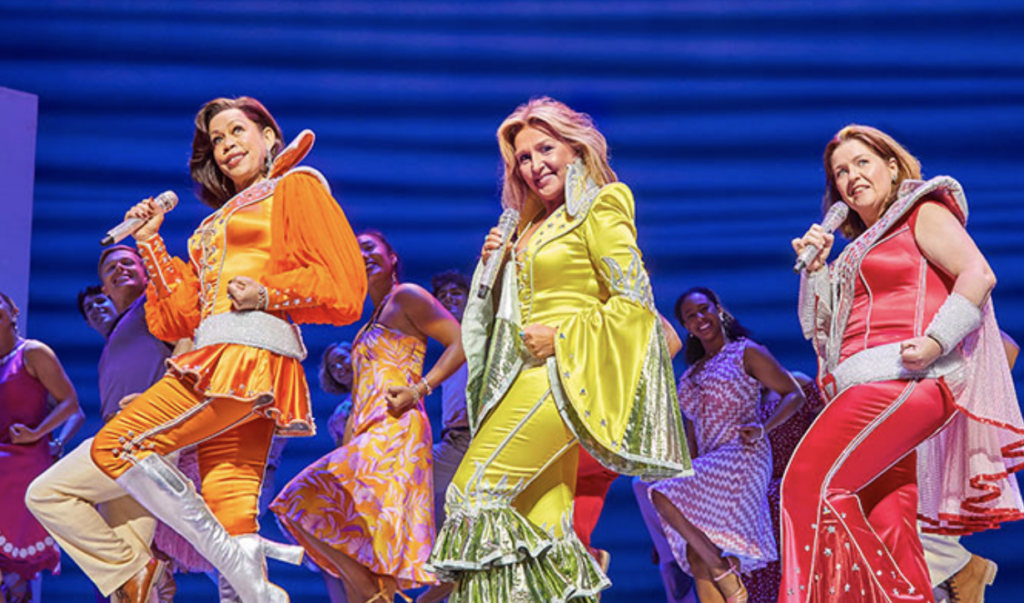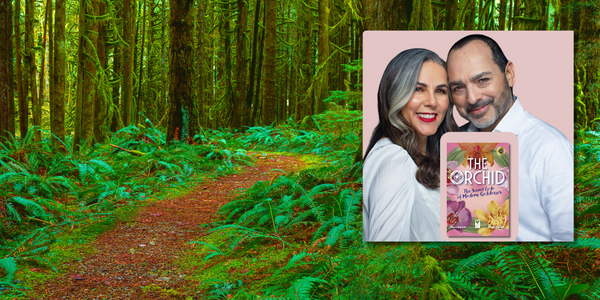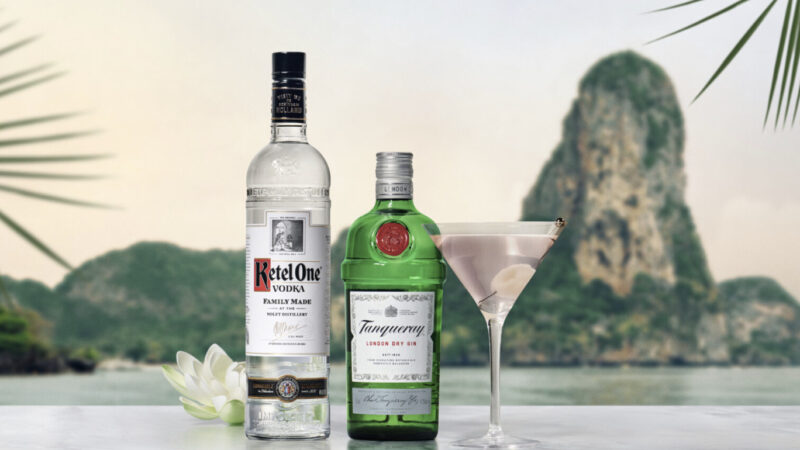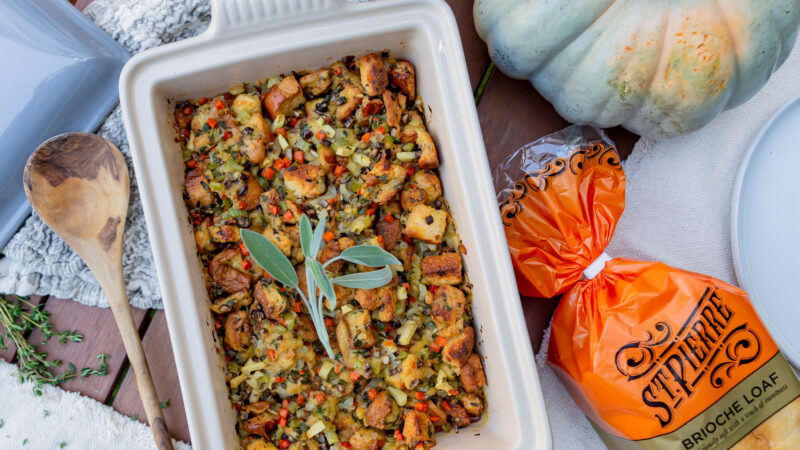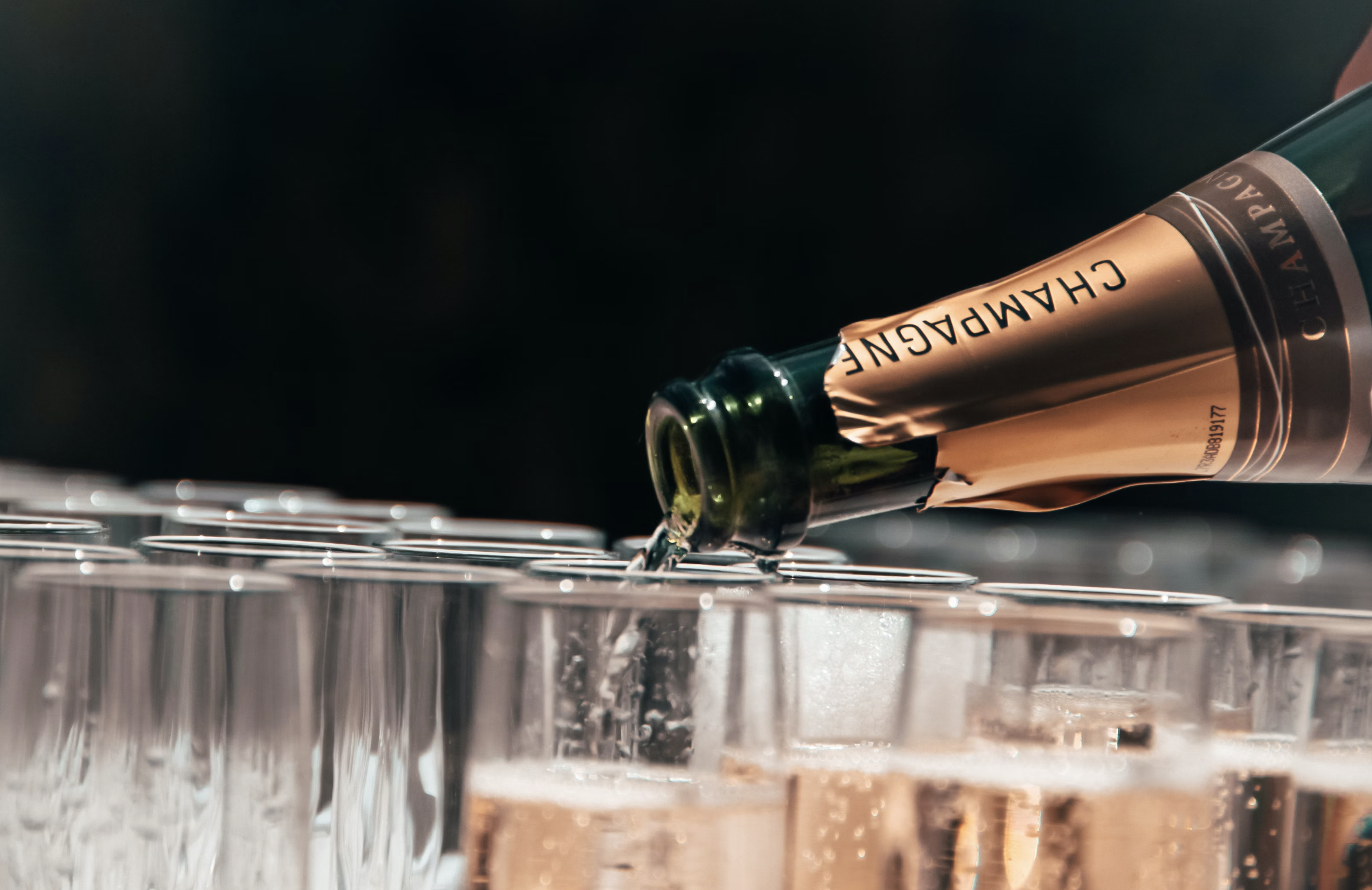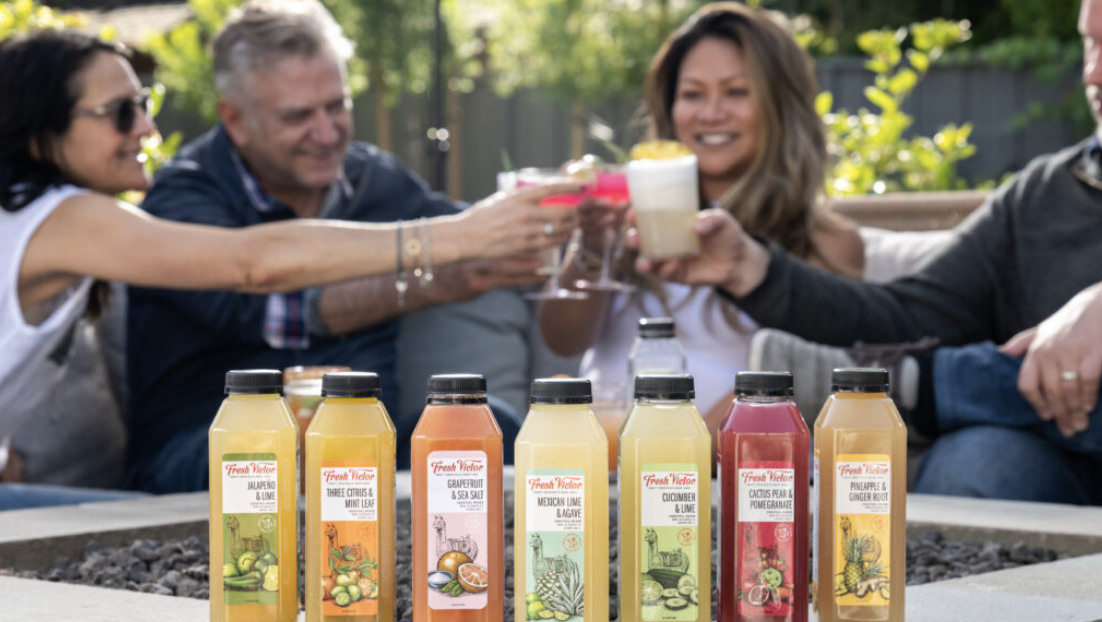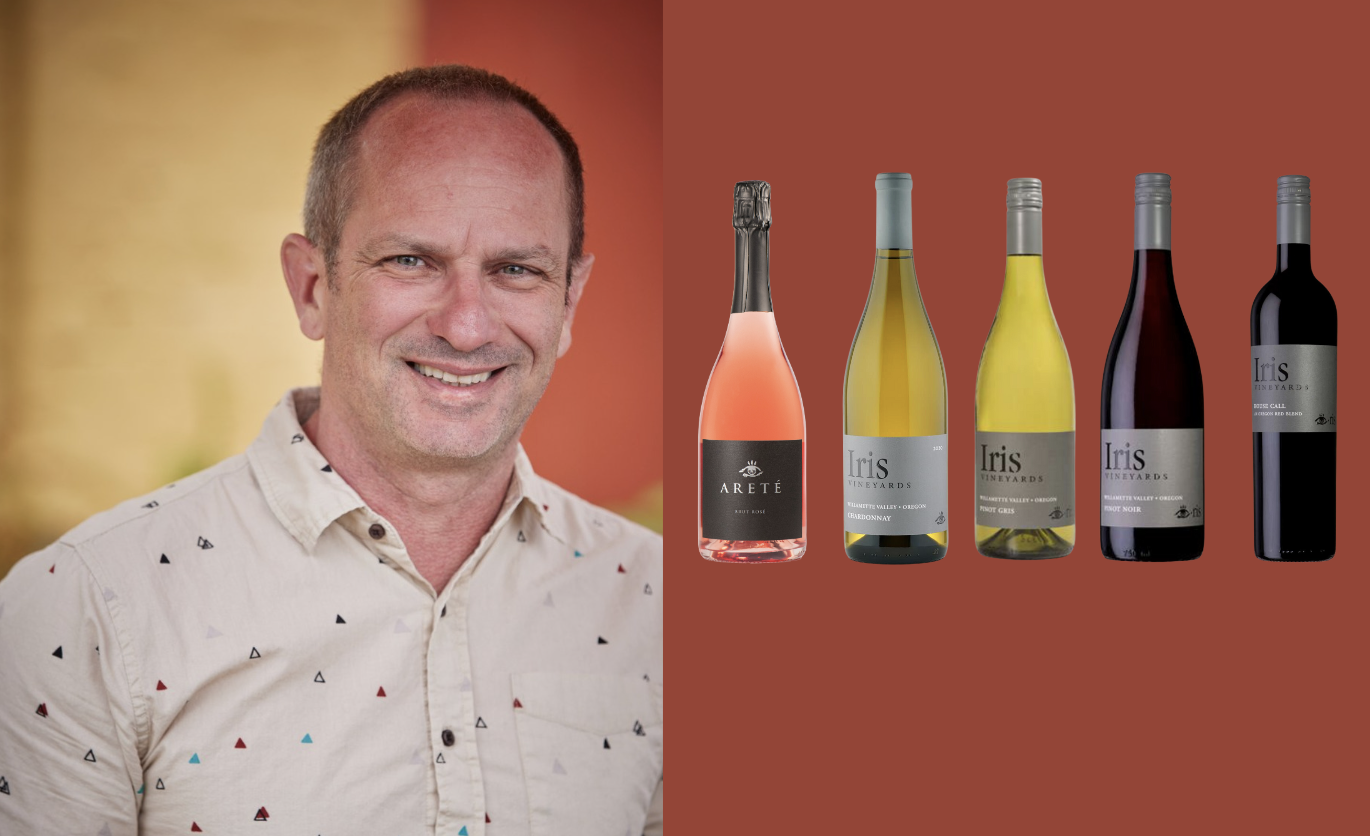Philly is Falling in Love! New Restaurant Indigo 52 offers flavor with a twist
Indigo 52 is a Nazareth restaurant gaining big buzz both in the Lehigh Valley and throughout the East Coast.
It’s not your average restaurant. There’s a twist.
The menu, the owner, the ingredients. Everything is special and there’s a reason why.

Lehigh Valley is falling in love with the flavors of Nazareth restaurant Indigo 52
It’s special enough to inspire families to drive hours just to enjoy a meal there. More about that in a minute, let’s get to the food.
Nazareth restaurant Indigo 52 Menu
Restaurant Owner Felicia Rocchino has a “Food Vision” for the items they serve and if you’re a foodie, you’re gonna love this:
All their dishes are:
- Unique – things you can’t find everywhere
- Better than what someone can cook at home
- Plated amazingly – be instagrammable!
Here’s what I sampled on my visit:

Indigo 52’s Cauliflower wings
Cauliflower wings
Grain-free battered cauliflower with maple garlic (you could also choose hot buffalo or mild sauce).
These were delicious and better than what I expected. The flavor, the breading; and each piece held together well, even after dipping.
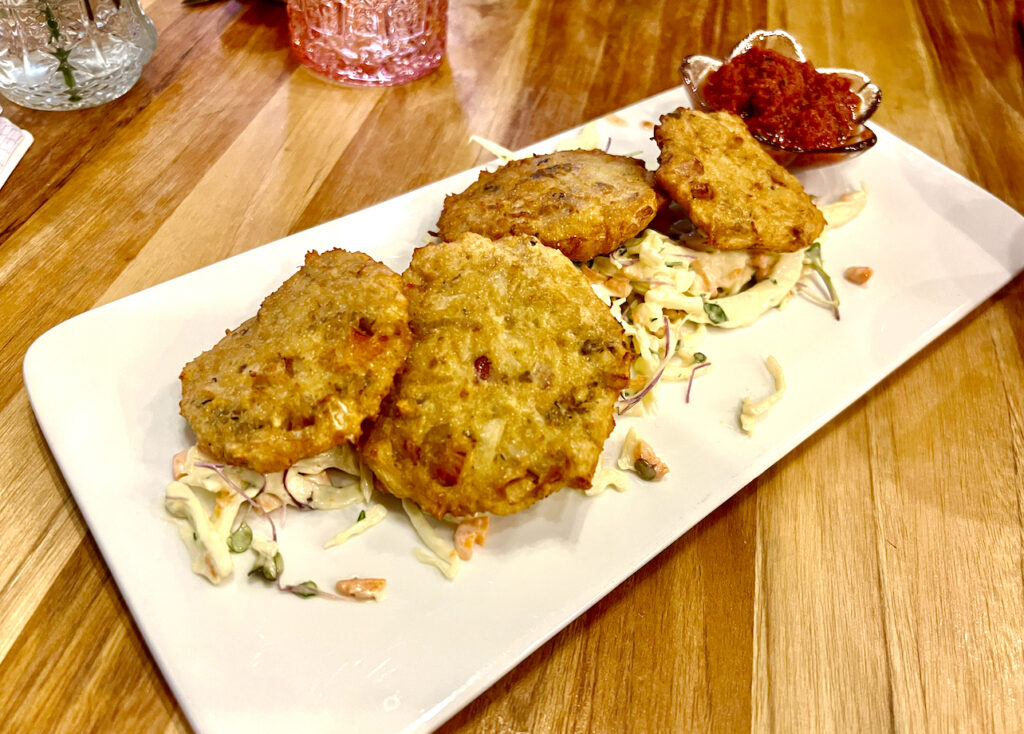
Indigo 52’s Vegan “Crab” Cake Bites
Vegan “Crab” Cake Bites
Mini heart of palm bites, seasoned, and served with a house made cocktail dipping sauce
Great flavor, very moist. The same tender and moist notes (like most vegan “crab” cakes) also made them fall apart easily. Delicious, but delicate.

Indigo 52’s Hand-cut Sweet Potato Fries
Hand-cut Sweet Potato Fries
Served with house-made maple garlic dipping sauce
I wanted these to be great and they were. Big flavor, excellent snacky side dish and the maple garlic is a winner.
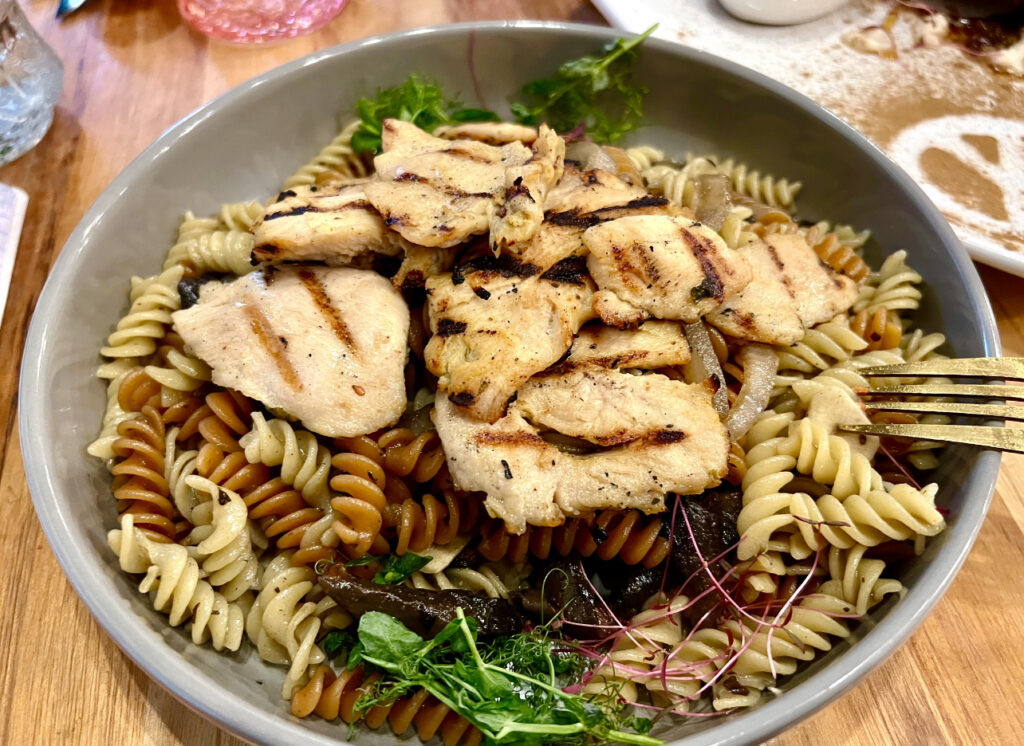
Indigo 52’s Chicken Marsala Rotini
Chicken Marsala Rotini
Anti-biotic free chicken breast, over pasta with julienne onions, mushrooms, organic spinach, fresh herbs, with marsala sauce.
This was the highlight. A very well-balanced dish. On different bites, the onion stood out, then the mushroom, then the marsala. There’s a lot of nuance here and the sauce pulls it together. Also, it’s a big portion. Take the remainder home and give yourself a present for lunch tomorrow.

Indigo 52’s Apple Pie stuffed French Toast
Apple Pie stuffed French Toast
3 slices topped with a house-made fresh apple cinnamon “filling”, house-made cashew cream, and 100% pure grade A maple syrup.
The brunch favorite brings a big bold flavor. And, again, a lot of food. Each bite makes you smile. If you’re into boozy brunches, this plate deserves a glass of bubbly.
Felicia’s Passion for Nazareth restaurant Indigo 52
Felicia is a triple-threat. She has a creative eye, a global expertise in restaurants and retail and she has a personal passion creating this concept to help others.
Creative in the way the restaurant looks and feels. It’s funky. It’s whimsical. It’s playful. As you walk in, the decor gives your eyes flavors to enjoy, while the menu handles your taste buds.

Indigo 52’s Felicia Rocchino and Chef Kadel Woody
Expertise from years at her previous corporate work helping successful restaurants launch and grow into hugely popular brands.
And personal passion. Yes, it’s very personal.
Recently, Felicia was living the life of a big city retail and hospitality professional based out of Philadelphia, helping restaurants grow and fulfill their professional dreams.
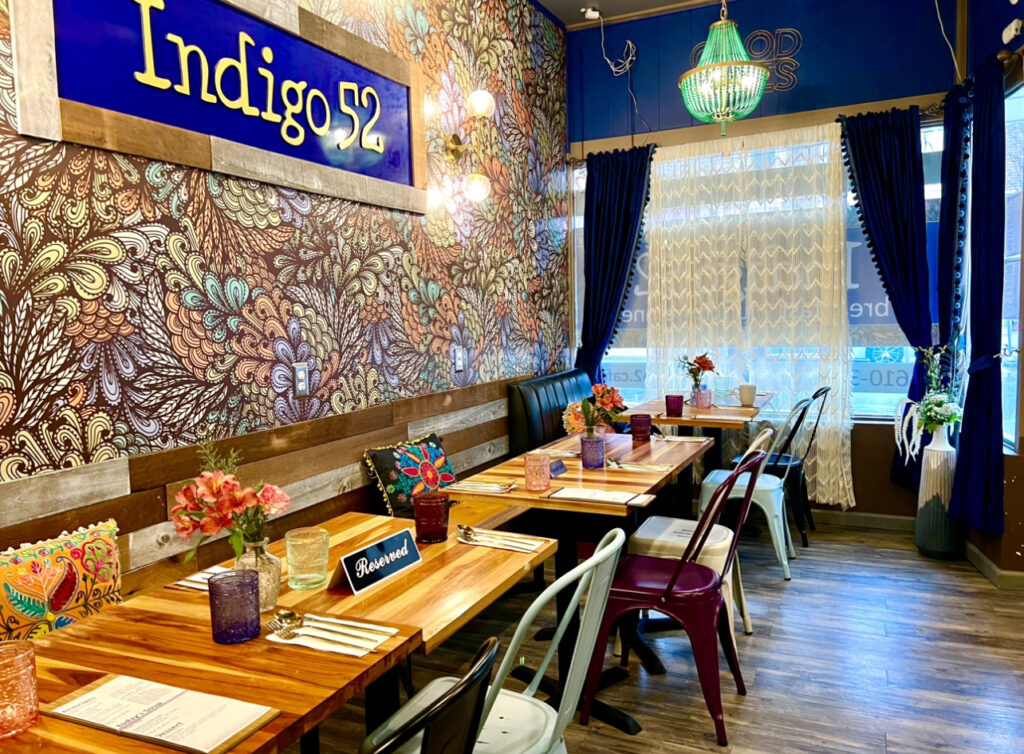
Indigo 52’s funky, whimsical, playful decor gives your eyes flavors to enjoy
Problem is, she was always feeling sick; and in and out of dozens of doctors offices trying to understand why. Year after year, test after test, with no answers.
One day, she met the right doctor who decided to give her a different test and there she learned the truth – Felicia has Celiac Disease.
Celiac Disease is sensitivity to gluten, which is a protein found in wheat, barley and rye, which is in… a lot of food.

Indigo 52 is gluten free and dairy free
Truthfully, many of us suffer from different nutrition allergies, with different levels of sensitivity in reaction. The statistic is 1-10 people.
A strong majority of people are un-diagnosed. Some people react with a stomach ache, others are rushed to the hospital for a few days of care.
Those who end up with stronger reactions (like needing a hospital visit) tend to never eat out or get take-out, because the risk isn’t worth it.
Even “gluten-friendly” food tends to not be so friendly. The restaurant and its kitchen needs to enforce incredibly disciplined action and even then, it’s still a risk.
But Felicia Rocchino’s Indigo 52 practices incredibly disciplined kitchen practices to make it safe for immune-compromised people.
And around the country, people are taking notice.
“That’s Just The Way Life Is.” Nah, it doesn’t have to be.
A local family always stops by the Nazareth eatery when they’re picking up their college-aged daughter because their family is immune sensitive and Indigo 52 is one of the only restaurants on the East Coast that truly offers safe food. So they’re willing to drive hours for a meal there.
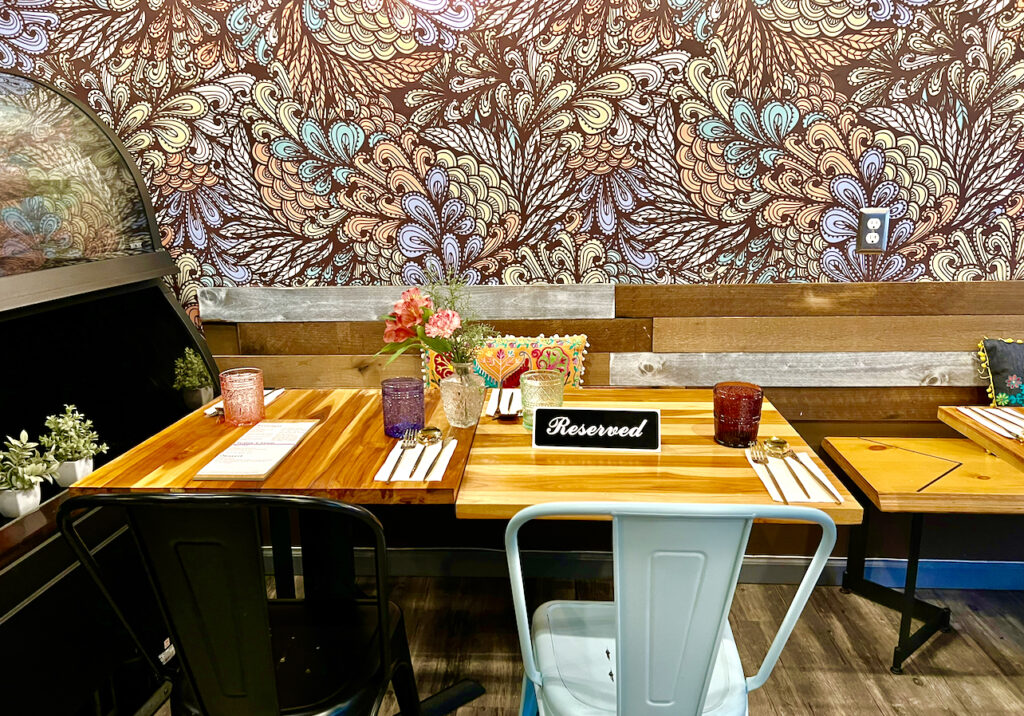
Indigo 52’s seating and decor
Same thing for a Lehigh Valley couple who became used to not eating out because of the risk. Then they tried Indigo 52 and to their relief, it was perfect. As a result, they even had their anniversary dinner there and Chef Kadel catered the menu toward romance.
Because of the growing unique demand, Indigo 52 has become reservation-only with diners driving from hours away to have a very specific and risk-free meal.
This Lehigh Valley restaurant has become one of the very few healthy (and delicious) stops on the East Coast to offer a consistently safe (risk-free) experience to immune-compromised diner. And word is spreading quickly.
Chef Kadel’s work is Art, Magic and Flavor
Chef Kadel Woody has been working in Lehigh Valley restaurants since he was in high school. Learning his kitchen secrets from time at Widow’s Tavern and Grille, Two Rivers Brewing, Anthony’s Coal Fired Pizza.
Felicia and Kadel connected when she knew she needed someone magical to create these unique and challenging dishes and her first several chefs couldn’t give her the results she envisioned.
Chef Kadel’s plating is art.
Chef Kadel’s ingredients are magic.
And the flavor is in every bite.
The kitchen is open so that diners can watch him create magic from their seat or even step over and get a closer glimpse.
Local Food Brings Big Flavor
Most of Indigo 52’s ingredients are local. Some come from Nazareth farms literally down the street from the restaurant and their delivery is walked over. That’s very local. That’s fresh.
Felicia and Kadel are big supporters of the local community handing out snacks at nearby businesses and contributing delicious bites at neighborhood events.
Indigo 52 Review
Cuisine: Very strong. From their locally sourced ingredients and an inventive menu, to Chef Kadel who’s able to create custom experiences for even the most sensitive diners.
Ambience: Fun, playful. Small town quaint with ambitious creativity
Service: Now that they’ve switched to reservation only, once you’ve been seated you get plenty of friendly and knowledgeable support. The kitchen proudly goes out of their way to service your specific needs.
Hospitality: Because Indigo 52 is such a unique experience, if you visit knowing how special your experience can be, the kitchen and staff go out of their way to surprise and delight you
Indigo 52 is located at:
52 S Main St
Nazareth, PA 18064
Indigo 52 is open Thursday – Saturday, 10a- 8pm, reservation only
Make a reservation here.
YOU MIGHT ALSO LIKE
Drink like a Movie Star: Clarendelle, Domaine Clarence Dillon Return as Official Wine Partner of 97th Oscars
Drink like a Movie Star: Clarendelle & Domaine Clarence Dillon Return as Official Wine Partner of 97th Oscars
Clarendelle & Domaine Clarence Dillon Return as Official Wine Partner of the Academy of Motion Picture Arts and Sciences, Academy Museum of Motion Pictures and Exclusive Wines Poured at the 97th Oscars Ceremony
Clarendelle and the family company Domaine Clarence Dillon announce the brand’s return as the official wine partner of the Academy of Motion Picture Arts and Sciences and the Academy Museum of Motion Pictures.
Wine for the Academy
The Academy Awards, renowned for their glamour and celebration of cinematic excellence, also feature a notable emphasis on fine wines during their events. A substantial amount of wine is served to accommodate the numerous attendees. For instance, during the 90th Academy Awards, over 2,400 bottles of wine were provided, equating to approximately 14,000 glasses.
Annually, the Academy hosts several official events where wine is prominently featured. The most notable of these is the Governors Ball, the official post-ceremony celebration, where distinguished wines and champagnes are served to winners, nominees, and guests. In addition to the main ceremony and the Governors Ball, there are various pre-show receptions and ancillary gatherings throughout the awards season, each offering curated wine selections to complement the festivities.
These events underscore the Academy’s commitment to providing a luxurious and celebratory atmosphere, with fine wines playing a central role in the experience.
For the third consecutive year, the prestigious family-owned wine company will exclusively pour exceptional red and white wines at the 97th Oscars® ceremony.
This partnership bridges the world of fine wine and film, elevating the Oscars experience for Hollywood’s biggest stars.
In addition to delighting guests at the Dolby® Theatre at Ovation Hollywood, Clarendelle and Domaine Clarence Dillon wines will be served at the iconic Governors Ball after the Oscars ceremony and the Official Oscars® Watch Party at the Academy Museum of Motion Pictures. This year, Governors Ball attendees can enjoy a glass of our elegant and contemporary wines while winners have their Oscar® statuettes engraved. The wines will also be perfectly complemented with a legendary gastronomic menu crafted by Wolfgang Puck Catering for an unforgettable evening.
“Before joining the family business, I began my career as a screenwriter, so to have the opportunity to partner with the Oscars for the third consecutive year is truly an honor,” said President and CEO of Domaine Clarence Dillon, Prince Robert of Luxembourg. “This collaboration is a natural extension of my family’s longstanding commitment and deep connection to film and the arts.”
Domaine Clarence Dillon will introduce two new wines for the star-studded events:
- La Clarté de Haut-Brion 2021: A sought-after white wine of rare delicacy with only 1,000 cases produced annually, La Clarté brings together the qualities of a fine white Bordeaux wine with fresh citrus and white flower aromas, followed by a crisp and refreshing finish of lemony brightness.
- Le Clarence de Haut-Brion 2015: Château Haut-Brion became the first Bordeaux vineyard to be named after its terroir, making the estate the first luxury brand in the world. The exquisite red Le Clarence de Haut-Brion 2015 is similar in style and elegance to its elder and encompasses all unique attributes of a fine wine with an attractive profile – smooth yet powerful, tasty and full-bodied, with notes of ripe fruit leaving an impression of freshness and volume, without heaviness.
Among the returning wine favorites are:
- Clarendelle Bordeaux White 2023: A refined and elegant wine, offering bright citrus notes of lemon and grapefruit, balanced by the smooth sweetness of pear and lychee.
- Clarendelle Bordeaux Red 2016: A wine with fruity aromas of red fruit and blackcurrant alongside floral overtones balanced by great tannic power and delicious velvety texture.
- Clarendelle Amberwine 2021: A complex, well-concentrated and modern sweet wine distinguished by its freshness and harmonious balance of floral fruit and acidity with a smooth finish.
Founded in 1935, Domaine Clarence Dillon is a family-owned group renowned for its prestigious Bordeaux estates, including Château Haut-Brion, Château La Mission Haut-Brion, and Château Quintus. Under the leadership of Prince Robert of Luxembourg, the company has earned a global reputation for excellence in winemaking, joining Primum Familiae Vini, an international association of some of the world’s finest wine producing families. Domaine Clarence Dillon has long been a supporter of the arts, with Prince Robert’s background and screenwriting playing an essential role in merging the worlds of wine and cinema by bringing Clarendelle and Domaine Clarence Dillon to the biggest night in Hollywood.
For more information, follow on Instagram @clarendelle @chateauhautbrion_ @chateaulamissionhautbrion @chateauquintus @leclarenceparis.
Philly Orders The White Lotus Season 3 with Patrick Schwarzenegger Sipping Ketel One Family Made Vodka and Tanqueray Gin
‘Sip into The White Lotus’ with Patrick Schwarzenegger for Season 3 with Ketel One Family Made Vodka and Tanqueray Gin
Ketel One Family Made Vodka, one of the bestselling and top trending vodkas (Drinks International, 2025), and Tanqueray Gin, the seven-time winner of the bartenders’ choice of gin (Drinks International, 2023), have long been at the forefront of cocktail culture, consistently shaping and elevating the craft with their unwavering dedication to quality and innovation.
The Cocktail Culture of The White Lotus: Sipping in Style
HBO’s The White Lotus isn’t just known for its biting satire and stunning backdrops—it’s also quietly shaped the world of cocktail culture. Set against the luxurious resorts of Hawaii and Sicily, the show’s characters are often seen clutching artfully crafted drinks, turning simple sips into statements about wealth, indulgence, and escapism. In Season 1, tropical classics like the Mai Tai and Pineapple Daiquiri make frequent appearances, aligning with the show’s Hawaiian setting and nodding to the tiki cocktail revival. These vibrant, rum-based drinks not only complement the scenery but also subtly underscore themes of paradise lost.
Season 2 shifts to Sicily, and with it comes a more European drinking aesthetic. Think Aperol Spritzes, Negronis, and chilled white wines, evoking la dolce vita while masking the tension simmering beneath the surface. The show’s cocktail choices aren’t just background props—they reflect character dynamics and mood. For example, Tanya’s over-the-top drink orders often mirror her chaotic, lavish lifestyle.
Since its debut, The White Lotus has inspired bartenders and fans alike to recreate its signature drinks, blending TV-inspired nostalgia with real-world cocktail trends. Whether it’s a Mai Tai or a Spritz, every glass tells a story.
In an exciting collaboration with Max and HBO, the two iconic brands invite fans of The White Lotus to experience the timeless elegance and charm that define both the series and their curated cocktail creations.
In anticipation of the series returning on February 16, on Max and HBO, Ketel One Vodka and Tanqueray Gin introduce, ‘Sip into The White Lotus,’ a dynamic, multifaceted collaboration which includes series-inspired cocktails, Thailand destination giveaway, immersive events and engaging content.
“Our partnership with Max and HBO’s hit series The White Lotus is a perfect blend of luxury and sophistication. The show’s exploration of timeless hospitality aligns perfectly with the craftsmanship behind Ketel One Vodka and Tanqueray Gin, both of which are synonymous with the highest standards of quality,” said Julie Yufe, Senior Vice President of Vodka, Gin and Rum at DIAGEO North America. “The show is a cultural phenomenon, creating its own universe of intrigue and vibrancy. As consumers increasingly value experiences, we’ve been intentional about crafting fan-centric moments where our brands can create memorable occasions with every sip.”
Inspired by the show’s luxurious destinations, the partnership with Max and HBO kicks off with an original short film starring actor and entrepreneur Patrick Schwarzenegger, who whisks viewers away to a dreamy Thai escape. As Patrick mixes The White Lotus Vesper Martini—crafted with Ketel One Vodka and Tanqueray Gin to embody the captivating elegance fans expect from the show—he invites viewers to immerse themselves in the world of The White Lotus, exploring its story, characters, and the lavish setting of the highly anticipated new season.
“Being part of the cast of The White Lotus has been an incredible journey, and I’m excited to partner with Ketel One Vodka and Tanqueray gin to bring fans closer to the unforgettable moments of season three,” said Schwarzenegger. “Just like these iconic spirits, The White Lotus is all about storytelling and savoring every experience. I can’t wait to watch the new season unfold while toasting The White Lotus Vesper Martini with friends and family.”
To toast to season three of HBO’s The White Lotus, Ketel One Vodka and Tanqueray Gin have crafted exclusive cocktails inspired by the season’s stunning Thailand setting: The White Lotus Vesper Martini and The White Lotus Punch.
The White Lotus Vesper Martini is an elegant twist on the traditional cocktail, featuring Ketel One Vodka and Tanqueray London Dry Gin as its smooth, classic base. It delivers a refined, refreshing tasting sip with a sophisticated balance of dry and fruity notes. A French white wine aperitif adds crispness, while lychee liqueur imparts a delicate floral sweetness. The White Lotus Punch strikes a perfect balance between tart and tropical, making it the ideal cocktail for any getaway. With a vibrant blend of Ketel One Vodka and Tanqueray London Dry Gin, it showcases tropical flavors of pineapple, mango, and lime. The gin lends a hint of herbal complexity, while the tropical fruits provide sweet, juicy depth.
The unique creations tap into a feeling of luxury familiar to a White Lotus guest while reimagining how fans can enjoy cocktails with a modern twist. Featured in The White Lotus limited-edition cocktail kits, these perfect accessories for viewing parties include everything needed to craft season three-inspired drinks at home. Fans 21+ can purchase the kits at https://www.cocktailcourier.com/pages/the-white-lotus-cocktails.
|
The White Lotus Punch ¾ oz. Ketel One Vodka ½ oz. Tanqueray London Dry Gin 1 oz. lime juice ¾ oz. mango syrup 2 oz. pineapple juice
Combine all ingredients into a highball glass filled with crushed ice and stir. Garnish with a pineapple wedge and serve. |
The White Lotus Vesper Martini ¾ oz. Ketel One Vodka ½ oz. Tanqueray London Dry Gin ¼ oz. French white wine aperitif 1 bar spoon or teaspoon lychee liqueur 1 bar spoon or teaspoon butterfly pea tea
Combine all ingredients into a cocktail shaker filled with ice. Shake and strain into a chilled martini glass and garnish with a lychee. |
Thanksgiving in Philly: perfect stuffing bread DOES exist – and it’s… [Find Recipe Inside]
This Thanksgiving in NYC, the perfect stuffing bread DOES exist – and it’s brioche. As in St Pierre Brioche Thanksgiving Stuffing
No Thanksgiving spread is complete without a hearty stuffing. While add-ins are a matter of preference, choosing the right bread is crucial. One underrated choice is eggy, rich brioche – and with St Pierre Bakery, you don’t need to go to France to get it.
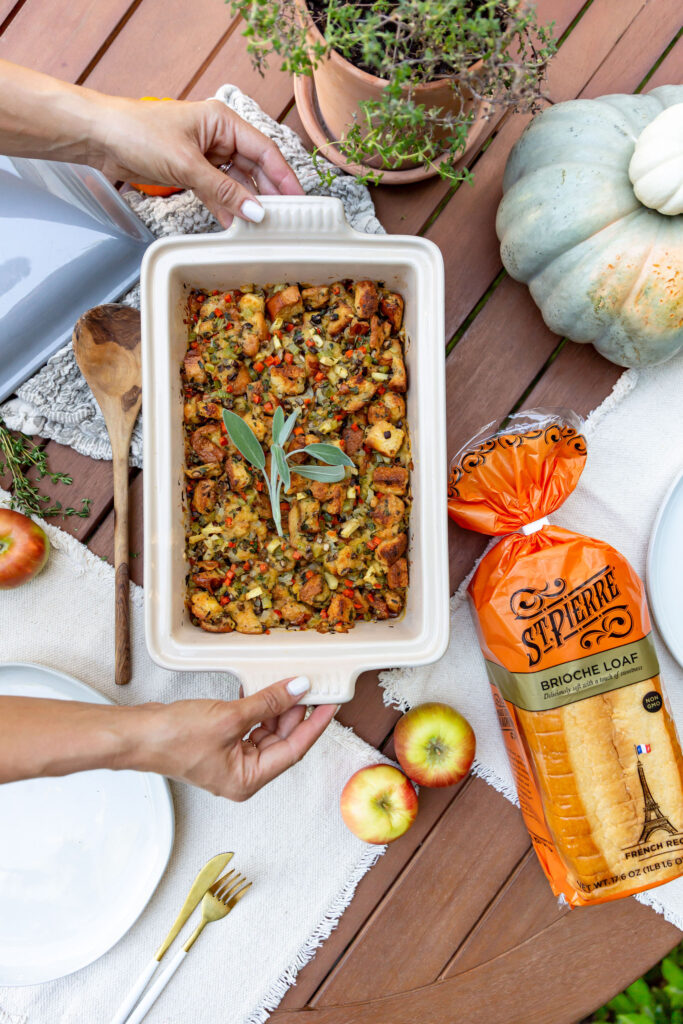
Thanks to its butter and egg content, St Pierre’s Brioche Loaf provides the perfect balance of crisp toastiness while remaining soft and creamy inside, while its lightly sweet flavor adds a decadent quality that can still lean savory. Attached below is an approachable recipe for stuffing allowing for all the craveable crunch for the whole family with minimal effort required.
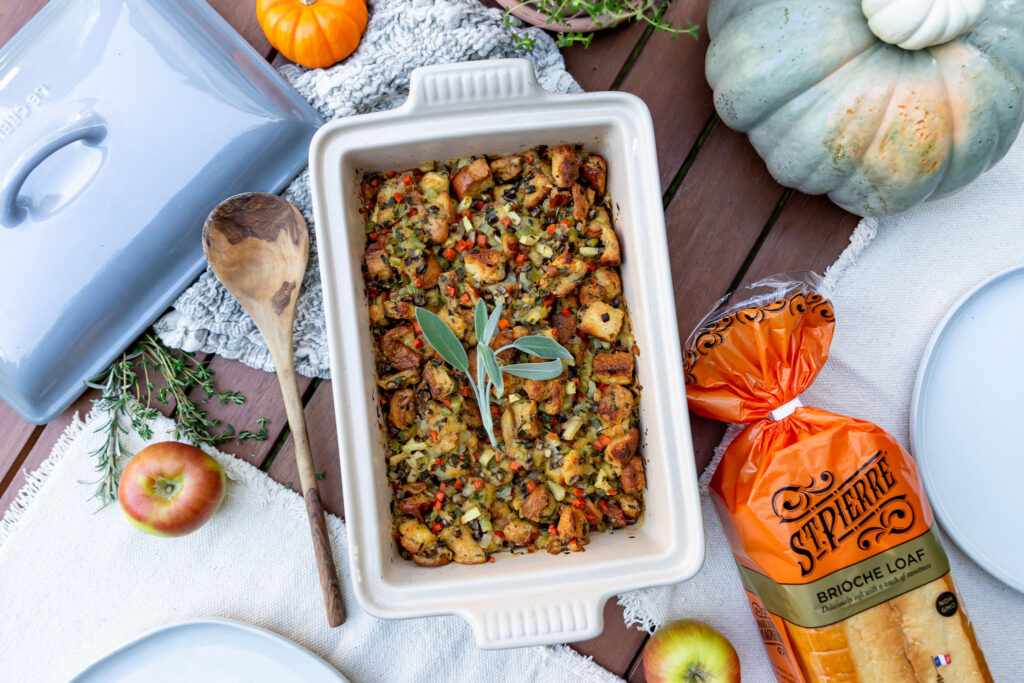
St Pierre Brioche Thanksgiving Stuffing
By @BrandiMilloy
Ingredients
1 loaf St. Pierre Brioche Bread
1/2 cup unsalted butter
1 medium onion, diced
3/4 cup celery, diced
3/4 cup carrots, diced
1 cup mushrooms, diced
2 large eggs
1 tbsp. fresh rosemary, chopped
3 sprigs fresh thyme, just the leaves
1 tbsp. fresh sage, chopped
1 small apple (granny smith works well), peeled and diced
Salt and pepper
Directions
-
Preheat oven to 350 F. Cut brioche bread into 1” cubes and bake for about 10-15 minutes until toasted.
-
Meanwhile, into a pot over medium high heat add butter until melted. Add onion, celery and carrots and cook until everything starts to soften, about 7 minutes. Add mushrooms and cook for 2 minutes longer. Remove from heat and set aside.
-
Into a bowl whisk together the eggs, herbs, apples, mushrooms, and salt and pepper. Add your cooked vegetables and mix to combine.
-
Pour mixture on top of toasted bread and stir to combine. Bake stuffing for about 45 minutes. If your stuffing starts to get too brown, cover until finished baking. Enjoy!
As America’s favorite brioche brand, St Pierre’s products are widely available via grocery stores nationwide as well as Walmart.
About the Author
Joe Wehinger (nicknamed Joe Winger) has written for over 20 years about the business of lifestyle and entertainment. Joe is an entertainment producer, media entrepreneur, public speaker, and C-level consultant who owns businesses in entertainment, lifestyle, tourism and publishing. He is an award-winning filmmaker, published author, member of the Directors Guild of America, International Food Travel Wine Authors Association, WSET Level 2 Wine student, WSET Level 2 Cocktail student, member of the LA Wine Writers. Email to: Joe@FlavRReport.comYou Might also like
-
Philly Wine: Wine Pro Alan Tardi Returns to NYC for Beyond Bubbles Class December 13
Philly Wine Lovers! Wine Pro Alan Tardi Returns to NYC for Beyond Bubbles Class December 13
Alan Tardi has worked as a chef, a restaurateur, a sommelier, a consultant to some of New York City’s biggest and best fine dining restaurants. He’s also written for magazines and publications, such as Wine Spectator, Wine and Spirits, Decanter, of course, the New York Times.
This past fall, Alan Tardi taught his very popular Italian Wine class, The Many Faces of Sangiovese.
Today Wine Expert Alan Tardi returns for a conversation about his new Champagne, Prosecco and Lambrusco sparkling wine class Beyond Bubbles on December 13 at New York Wine Studio.

NYC Wine: Wine Pro Alan Tardi Hosts Popular NYC Wine Classes: Beyond Bubbles on December 13
Alan, thank you so much for coming back. You have a new class called Beyond Bubbles.
Can you just give us an idea of Beyond Bubbles about the class itself?
Alan Tardi: The class is going to take place on December 13th. That’s a Wednesday from 6 – 7:30pm. And the venue is the New York Wine Studio located at 126 East 38th Street between Park and Lexington, so a couple blocks away from Grand Central Station in New York City.
It’s going to be called Beyond Bubbles. I’m really focusing on three archetypal sparkling wines. Champagne, Lambrusco, Prosecco.
And I have to say Prosecco from the original growing area, Cornigliano Valdiviadene, not the extended one right now.
These are the sparkling wines that, to me, took their own path and they can, in the case of Lambrusco and Prosecco they’re really ancient grape varieties that have been going on for a very long time.
Champagne, they’ve been making wine for a very long time. But as we’ll talk about, which is really fascinating, they’re adjacent to Burgundy and they’re both in close proximity to Paris where the King and the royal kingdom was. They were very competitive with their wine.
The counts in Champagne and the Dukes in Burgundy. They were really vying for their wine for the favor of the King. But Champagne, like Burgundy, began making it for a long time, hundreds of years, still wines. And when, and that was what they made for a long time.

In your class Beyond bubbles, can you give us an idea of how many bottles are going to be tasting from and learning about, and maybe one or two that are extra special to you?
Alan Tardi: We’re going to be tasting 10 wines. Three from Lambrusco, a very misunderstood wine. The grapes for Lambrusco are wild. Prosecco and Champagne.
The class is Beyond Bubbles. Wednesday, December 13th, tickets are on sale. Now it’s coming up very quickly.
Let’s really dive deep for a second and just get to know champagne’s history. The whole idea of sparkling wine was an accident.
Alan Tardi: Yes. It was originally considered a flub because they were trying to make still wines to be in competition with Burgundy and they were very good at it. The still wines of Champagne were highly regarded.
So it did happen by accident. What happened is that Champagne is much further North than Burgundy. It’s at the breaking point beyond 45 degrees North where grapes can’t grow anymore. So they had a hard time making wine. it got very cold after harvest. One of the big customers for champagne was England and they shipped a lot of wine in barrel to England.
They were put into barrels once the fermentation stopped, because it got very cold and then they would ship them to England eventually in the springtime..
Because they finished their fermentation too early because it got cold, the fermentation stopped. Once it got warm again, the ferment: the remaining sugar went to work on the remaining yeast and it created bubbles in a closed container.
So when people opened up the barrel, it was fizzy.
When that happened in France, people did not like it because it was considered a flaw. England didn’t have a problem with that.
Eventually the producers said, wow, these people really want to have the bubbly wine. The King of France became very fond of this wine. So it really took off from there, but it happened in England first.
Talk a little bit about who “The Father of Champagne” was and how he tried to prevent this from happening.
Alan Tardi: It’s a really great story. Dom Perignon is considered to be the father of champagne. He was a chef and while he was a monk, he took over as the steward.
The convent had a lot of land given to them as dues to the church. He was managing the winery there in order to sell wine to support the monastery.
He would select different grapes from different places. He created fractional blending and fractional pressing of the grape so it’s very gentle and soft, which is very important for the development of champagne. But this was a still wine.
He was trying to make a still wine. When it spontaneously started sparkling, he considered it a flaw. He tried to avoid it with everything that he could possibly do.
It became extremely popular.
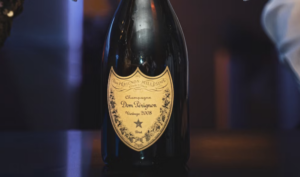
He said, “Brothers, I see stars in my glass.” And he was supposed to be blind by that point.
This whole thing of Don Perignon being the the father of champagne and seeing stars was made up as a marketing ploy by Robert de la Vogue, who was the head of a major champagne house. So they created this story around it. It’s a great story. I love it.
I wonder if that’s one of the reasons why champagne does swell during the holidays. When there’s decorations out and it really is a celebration.
Alan Tardi: I think it is. Sparkling wines bring something with them. There’s this effervescence, It’s like shooting stars. When they’re in the glass and you’re, you put them in your palate and they’re tingling and that’s all good.
Once the sparkling version was approved around 1725 by the King, it expanded throughout the world, it was a worldwide phenomenon.
You’ve mentioned the words method and process, share more about traditional champagne method?
Alan Tardi: It is a very stable process. You have to make a base wine. So you ferment grapes. They started sourcing different grape varieties from different areas throughout the extensive Champagne area. They would blend them together to make a decent wine. That’s the first fermentation.
Then they add a liqueur, called the tirage in French, it consists of primarily sugar, could be beet sugar or cane sugar; and yeast.
They’re put in individual bottles and then the bottle is sealed with a crown cap to keep the wine in the bottle. They would sit in a cellar for a period of time to create the secondary fermentation in a closed container. Like the initial fermentation process where the sugar goes to the yeast that is added to it. That creates a combination of sugar and yeast creates alcohol and carbon dioxide.
The carbon dioxide goes up, the alcohol stays in, and that’s how wine is made. But because [in still wine] it’s in an open container, the carbon dioxide goes out.
In a closed container [like in sparkling wine], in this case, a bottle, the carbon dioxide that was given off from the second fermentation was trapped inside the bottle. So once you open the bottle, the carbon dioxide would come up and out. And that’s where it comes from. That is what gives it the sparkle.
In Champagne, their method is known as the Method Champenoise.

They carry out the secondary fermentation in a closed bottle. Then, in the third part, they make the method Champenoise. It’s removing the sediment from the wine. There are many different ways to do it.
The most important common grapes for sparkling wine are Pinot Noir, Pinot Meurnier, Chardonnay. But your class reveals “lost grape varieties”. Tell me more about that.
Alan Tardi: These were grape varieties, typical of the area, that were used initially, but then people just put them by the side. The most important grape varieties were Chardonnay and Pinot Noir. Meunier was used as a workhorse, a filler, but it didn’t have the same identity that that Chardonnay and Pinot Noir had. Those are the three principal ones. Then [there was] these other varieties.
There’ve been major changes in the past 10 – 15 years in Champagne. It was driven by the Maison. Thousands of growers who supplied grapes to the Maison. Many times they would actually press the grapes, vinify the wine and then send the wine to the Maison.
They produced it for the houses. They didn’t have their own labels. That changed. A lot of the grower producers started labeling and selling their wine on their own. They got a lot of attention.
Some of these people were very loyal to the old grape varieties that were left on the side – they like Pinot Blanc, Pinot Gris – not very rare grape varieties, but people are not aware they are part of the grape varieties of Champagne.
Some people are really trying to promote those because it’s part of their culture. It’s part of their history.
There’s two others, Petit Mellier and Arban. It brings a whole new aspect to Champagne.
So we’re talking with Alan Tardi. On Wednesday, December 13th he hosts his new class Beyond Bubbles. One of those bubbles we’re going to be talking about is Prosecco. Frizzanti, Spumanti. Help us understand what these words mean, the region, how it all relates
Alan Tardi: Prosecco is one of the most misunderstood wines out there. There’s a lot more to it than most people are aware of. It’s not just a base for a Bellini or a cocktail, or just a cheap fix. There’s a lot more going on there than often meets the eye.
It’s a very old wine growing area. The original area is Conigliano Valdobbiadene. Fifiteen towns that make up the area in the hills just at the foot of the Dolomites in Veneto. They’ve been making wine there for a long time.
I have a feeling that the people who originally planted grape vines there were members of this Celtic Ligurian tribe that were up in Northern Italy, like in the Botellina and over in Liguria. They have this amazing capacity to plant vines in places where it’s very difficult.
Prosecco is very different from Champagne. I was living in Italy. I was going to Prosecco a lot because I did a story for Wine and Spirits Magazine about the Cartice area in Val di Biadena.
It blew my mind away. At the same time, I was starting to go to Champagne to research my book and I spent a lot of time there. I was finding a lot of similarities between these two very different wines.
Champagne began as a still wine called Coteaux Champenois. It had another wine in between. A sparkling wine, but a softer, lower amount of pressure called Cremant de Champagne.
In Prosecco, the traditional way of making wine was fermenting the wine. Then, they would put it in a container, either a barrel or a cement tank or in a bottle. The same thing happened. The fermentation would stop prematurely because it got too cold. Then, in the spring, when the temperature rose, the wine would wake up and the sugar would go back to work on whatever yeast was left.
Being in a closed container it would be fizzy. Now, in the bottle. The Italians had no problem with the sediment in the bottle.
I remember going there in 2013, I heard about this kind of Prosecco where the sediment was left in the bottle and people were a little bit embarrassed to show it.
This is actually called the Method Ancestral like they did in Limu.
They left the sediment in the bottle. It was just part of the wine. m In 1895, someone at Vinicultural Research Research Center in Asti named Martinotti, figured out they had a lot of sparkling wines in that area like Moscato.
Martinotti invented a system instead of having to do this process in the bottle, he created a large container with a top under pressure where the second fermentation could take place under pressure and then bottle it from there. It’s called the Martinotti Method that he created and patented in 1895.
Then 15 years later, in France he applied a sterilizing system. It’s referred to as the Sharma Method. That is the typical Way to make Prosecco not the traditional way.
Most producers in the area did not advance their methods until after World War II happened.
Mionetto, a very big Prosecco producer, only started using autoclaves in 1987.
At my tasting in New York on December 13, we’re going to taste three Prosecco’s. One is a still version from a winery called Bortolomeo, one of the most significant wineries of the area
After World War Two, he was very instrumental in creating a small group of producers and protecting their tradition of making wine in the area.
Now their daughters are running the winery. They’re still making a Prosecco. It’s part of the disciplinary of the rules for Prosecco Cornigliano Valdobbiadene.
That used to be the same with Coteau Champenois, the still wine of Champagne. You would not find those around.
While we’re talking about Prosecco, tell us about their growth — between the DOCG and the DOC?
Alan Tardi: One thing I want to say is that in the very small area of Corneliano, Corneliano about to be out in a Prosecco, DOCG. In about 2009, because of the large demand for Prosecco, and because of the fact that people were growing grapes and making wine outside
That appellation covers the entire region of Friuli and three quarters of the region of Veneto. So it’s a huge area, mostly flat. Higher yields, most of the vineyards can be worked, can be harvested mechanically. It’s a very different wine and that accounts for the vast majority of the 500 million bottles that are being produced.
The little area up in the hills has a much more complex growing area, soil to topography.
It hasn’t really been touched since the earth rose when that, when the sea and the sea receded on the other side of Cornigliano, there was a glacier that happened up in the north and it came down and just took all the land with it.
If you look at the map, the part is very narrow and the Cornelia part spreads down and is very wide and lower altitudes. So you have two very different soil makeups and different sections within the area. So it’s much more complex.
In 2009, they created the DOC and that’s when the original area, called Prosecco, changed its name to Corneliano Valdobbiadene and they were elevated to a higher level, a DOCG category.
They created subzones within this very small area. 43 different areas within the overall territory. If grapes come from one of those areas, they can have the name of that on the label.
At Beyond Bubbles on December 13, we’re going to be tasting the Tranquilo Prosecco from Botolomeo. We’ll taste a Colfondo from a young guy who’s been carrying on his family’s winery.
He always made wine in the cofondo method, and he just also started using the method traditionnel as well.
We’re going to taste his Cofondo, and then we’re going to taste Prosecco, Brut Nature, no sugar added, from the Cornigliano side, different softer, denser soil, lower altitude.
You can taste the difference.
That sounds incredible. We’re celebrating Beyond Bubbles, Alan Tardi’s new class coming up December 13th. One of the bottles, the Lambrusco. Can you talk a little bit about its reputation?
Alan Tardi: I think we should feel very excited. In the United States people still think about Lambrusco as a sweet, red, bubbly wine.
Lambrusco has really changed and it’s very complex. Usually wines don’t do well in flat areas, but in the Po Valley, that’s where they come from, they started out as wild vines.
They were cultivated by this old ancient tribe who lived in the area from about 12 to 6 BC, and then they just disappeared There are 12 different Lambrusco grapes. Three of them are really the most important because they have their own distinct identity and growing area.
Sorbara comes from the town of Sorbara, takes its name after it, and it has its own appellation.
Grasparosa di Casavetro, down in the south, it’s flat, but it starts to go up a little bit into the hills.
And then Salomino, in the north, which is the powerhouse of the three.
It’s really fascinating. They’re considered to be the most elegant because they’re all red grapes. In Champagne, it’s mostly white grapes. in Prosecco, the grapes are also predominantly white. There’s Pinot Noir that was one of these international grapes. It was permitted but only as a
The Sorbara is very light, transparent, elegant. There’s a lot of finesse to it.
The Graspa Rosa is dark red, juicy, fruity, floral, intense, foamy.
The Salomino is the workhorse, Sorbata is not self pollinating. And Solomino is often the pollinator for Sorbata.
At Beyond Bubbles on December 13, we’re going to be talking about unusual bottles. Tasting a Salomino wine from a winery called Lini 910, a wine is made using the method Traditionnelle. This wine is going to be 2006 vintage, and it’s spent nearly 14 years on the lees.
At our Beyond Bubbles class, I’m going to start with the Lambrusco, the oldest of the wines. Then the Prosecco. Then the Champagne. So there’s a buildup to that.
After the champagne, there’ll be a still champagne from the Valley de la Marne from the Mounier grape, and the Philipponat Champagne vintage.
After that, I thought it would be really interesting to look at two wines from made by people who went to the champagne area in the turn of the 20th century and they fell in love with champagne and they were compelled to go back to where they came from and make a wine using the champagne style method in their own way.
A wine from Trentino, Giulio Ferrari. And the other one is RTOs in in Catalonia in Spain, compare.
Alan Tardi’s class Beyond Bubbles will take place December 13, 2023 at New York Wine Studio. 126 East 38th Street New York, NY 1001. Readily accessible between Park and Lexington Avenue, just minutes from Grand Central Station.
For tix and more information visit NewYorkWineStudio.com
Post Views: 7,129 -
The Holidays Just got Tastier! Fresh Victor Organic and Full Flavor Mixers for your Cocktails and Mocktails
Holidays 2023: Fresh Victor Puts the the drinker in charge with Fresh, Organic and Full Flavor Mixers.
Fresh Victor is how you make fast, delicious craft cocktails and amazing mocktails — Every. Single. Time.
Fresh Victor is a line of premium mixers for consistently delicious and efficient cocktails (and mocktails too.)
H. Ehrmann knows his cocktails
H. Ehrmann is a bartender and drinks industry consultant who runs Elixir, one of the most influential bars in San Francisco. In the industry for 35 years, owned a bar for 20 years.
Recently he hosted a virtual mixer walking us through several cocktails using Fresh Victor as the mixer: from non-alcoholic, to low alc, to full alcoholic.
Cold-pressed juice-based cocktail mixers. They have added sugar, either organic cane sugar or agave nectar used to balance out citrus levels to hit the intended brix level for most cocktails.
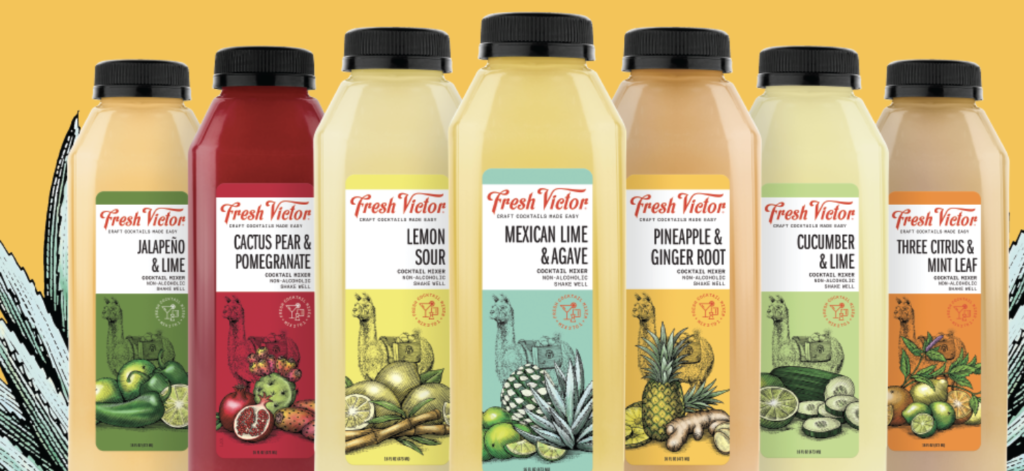
For example, with the Lemon Sour, the base is known as a pretty simple flavor profile. You can add another layer of flavor complexity (like a liqueur). But the Fresh Victor mixer was designed to have more depth, a bit more bitterness to handle any additional sweetness added.
Fresh Victor +1 or +2
All of the Fresh Victor bottles are designed to make delicious cocktails, but simply and easier. How? The amount of cocktails that can be made by adding just 1 or 2 ingredients plus the Fresh Victor mixer.
+1 is agave and tequila. Lemon Sour and whiskey.
+2 might be carbonation, frothing, aromatics, like: tonic, soda water, champagne, egg white, bitters.
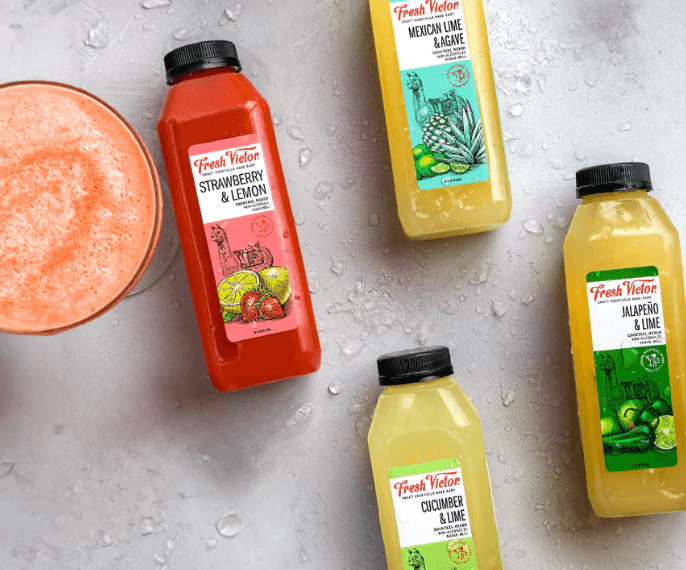
“2-3 pours and a lot of flavor”
– H. Ehrmann
With those 3 elements and Fresh Victor’s 9 flavors, you can end up with dozens of drinks. From classics, to a spin-off of a classics (including mocktails).
Mixing ratios: 1: 1 and 2: 1.
1 1 / 2 oz of spirit to 2 ounces of mixer
2 oz of spirit to 2 ounces of mixer
If the drinker likes the taste of the alcohol, they want that taste to “punch” through, then then 2:2 is better for them. If they want the flavor sweeter, iding behind the mixer, 2:1 is the answer for them.
Fresh Victor is a mixer, not a juice. So it’s meant to take on dilution as you build your cocktail. Right out of the bottle, it’s a bit more concentrated, more dense. Meant to be stirred, shaken, reduced down without watering down the flavor. It can dilute 15-20% without losing quality.
Using Fresh Victor, you can create a 32 oz, 64 oz or a gallon punch bowl for a holiday party in less than 5 minutes. And it’s not a simple, lame flavor. It’s complex.
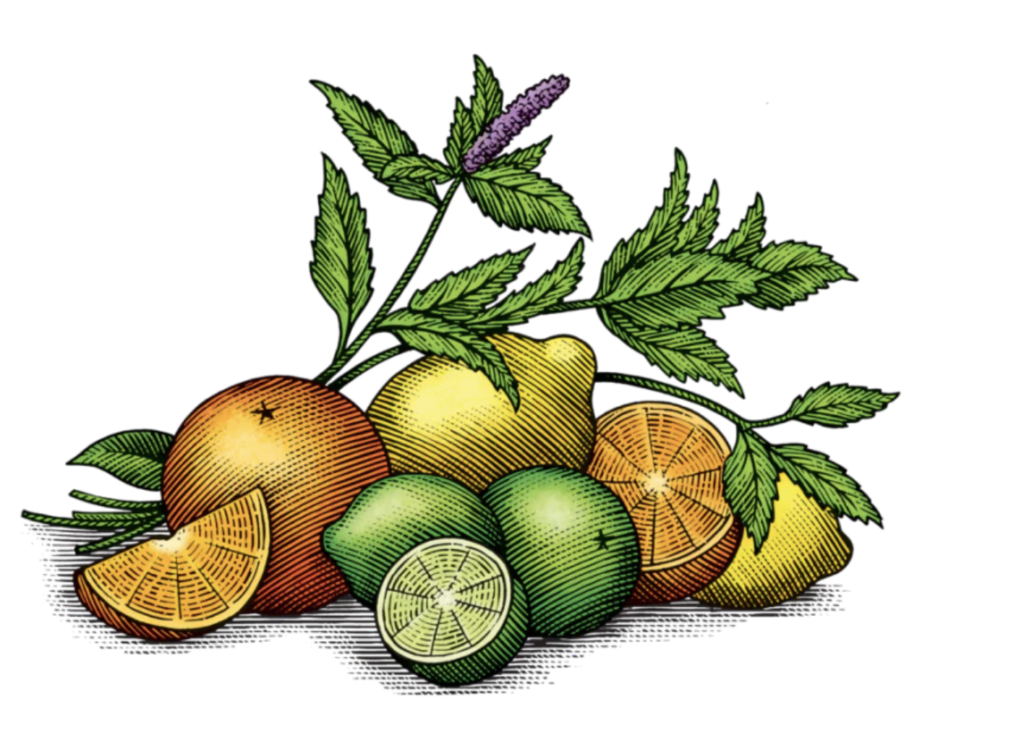
Orchard Bliss Royale
Non-alcoholic. When you add Champagne or Sparkling, it’s called “Royale” and today’s drink is adding Sparkling Cider.
4 oz sparkling cider
2 oz Fresh Victor (Three Citrus and Mint Leaf)
Garnish with dehydrated apple slices
The nose is refreshing. Vibrant apple. Effervescent on the palate, from the Sparkling. A balance of lemon, lime, orange. Plump, but not overwhelming. Mint notes that bring a tertiary element.
Suggestions include playing with adding a shot of vodka, rum or tequila, any of which would work well.
Fresh Victor mixers give a fruit-forward base that makes it easy to play and experiment with.
Winter Spice Tonic
“When mixed well, Gin impacts the overall character of your drink, but doesn’t get in your face”.
1 oz Tanqueray london dry gin
1 Oz Fresh Victor (Cactus Pomegranate)
4 oz Fever Tree Tonic
Aromatic bitters
Garnish with vanilla bean, All-spice berries, Dehydrated Lemon
The nose is immediately the charming, floral aromatics you’d expect from the gin. Then slowly the baking spices express themselves. Deep character layers and complexity. A gush of tonic, then lingering vanilla and lemon.
Definitely a gin drink for someone who’s not a gin fan as it showcases the best of gin without being overwhelming.

H. Ehrmann with the Fresh Victor Winter Spice Tonic
Love a standard gin drink? Try Gin and Tonic with Fresh Victor’s Cucumber and Lime!
“I’ve taught cocktail classes for over ten years. As much as students love it and geek out over cocktail details at the bar. When they get home to their kitchen, they still prefer to have something easy. That’s a huge part of when Fresh Victor is.”
“The 2 things that show us down when drinking cocktails, alcoholic strength and bitterness. Those are things that help us drag a cocktail out 10-20 minutes. Like, intentional speed bumps to keep you from drinking too fast. So removing the alcohol from a recipe, removes that speed bump. Adding more bitters, adds it back. It helps a non-alco drink feel more like a cocktail.”
“Just before Covid, we decided to focus Fresh Victor on bars and restaurants. So Covid hits. We decided to re-package into a 16 oz bottle. Within 6 weeks we had these bottles available in 7 states direct to consumer. Within 2 months, we had 48 states direct to consumer. I shifted to selling cocktail kits from home and Fresh Victor was the perfect partner for me.”
“Take a liter of tequila and a 64 oz bottle of Mexican lime and agave, you can make 32 margaritas. I was selling those kits like crazy. People were re-ordering every other day.”
“All the ways you can use Fresh Vector. I went through the lexicon of cocktails. What can I make with lemon sour? What can I make with Mexican Agave? Then I’d look at more unique flavor profile and ask myself what can I make with that?”
Figtorious Celebrations
2 oz of Fresh Victor (grapefruit and sea salt)
2 oz VSOP brandy
1 / 2 oz fig syrup
Try thinking of Fresh Victor less as a mixer or a juice and more as an ingredient. Think of it as an ingredient where you can use as much or as little as you want to make a more complex drink.
Explore from a culinary point of view. What other flavors mix?

H. Ehrmann with the Fresh Victor Figtorious Celebrations
Fresh Victor Holidays Flavors
H. Ehrmann suggests a twist this cold, holiday season. Think like a Hot Toddy. Simply warm up your Whiskey Sour, Lemon Drop, even your sangria. Anything that would normally go with ice, this time heat it up warm and toasty.
Post Views: 1,224 -
Philly Loves Oregon Wines – Flavor Revealed by Winemaker Aaron Lieberman from Iris Vineyards
Philly Loves Oregon Wines and its incredible new vintage with Winemaker Aaron Lieberman from Iris Vineyards
Sure, Oregon Wine is world-famous for its Pinot Noir. And rightly so, as the area produces incredible expressions of the varietal. But that’s not all they can do.
Award-winning winemaker Aaron Lieberman wants the world to taste and discover all of the incredible wines from the area including Iris Vineyards’s new Pinot Gris which has won acclaim several years in a row.

Today, Winemaker Aaron Lieberman from Iris Vineyards sits down over zoom to talk about his inspirations, his favorite wines, food pairings and what’s next for Oregon Wine.
The conversation has been edited for length and clarity. Find the whole conversation on our YouTube channel.
There’s so much to go over with you because you’re in a great area of Oregon.
Last year we had the privilege of covering the 2022 McMinnville Wine Classic, your Pinot Gris won Best in Show and Best White varietal.
According to press announcements it’s the first time ever for a Pinot Gris. What was it about that bottle and that year that brought you so much acclaim?
The vintage we won that on was the 2020, and I think our Pinot Gris is fairly consistent. So I actually personally felt that the 2021 vintage was better than the 2020. What I think is going on there is that in our growing area Southwest of Eugene we have our vineyard in what’s called the Lorane Valley. We’re a relatively high elevation vineyard compared to the rest of the Willamette Valley. We get a lot more hang time on our Pinot Gris, which allows more flavor development and preservation of acidity, as well as slower and lower accumulation of sugar.
So we ended up with a higher acid, lower alcohol wine that’s very expressive in terms of fruit flavors.
I wanna let our audience know a little bit about your background and what brought you to where you are today. Your education in soil and winemaking, but I hope you’ll touch on your Peace Corps time, and your work in Guatemala with soil education.
As I was finishing up my Bachelor’s Degree at Oregon State University, I became involved with a couple of different grad students, helping them with their research projects, basically. At the beginning of my junior year [I had already] switched my major from Pre-Vet to Crop and Soil Science.
So the projects I was working on with these grad students involved soil research. One of these grad students had been in the Peace Corps and talked about it frequently and also had a professor who had been in the Peace Corps. They both inspired me to look into it and do it.
I ended up going to Guatemala. The project I worked on was called Corn and Bean Seed Improvement and Post Harvest Management. We were trying to counteract the invasion of commercial corn seed into Guatemala and Latin America. It’s replacing the land raise varietals or the traditional varietals of corn. We were working with those traditional varietals to improve their performance in the field by selecting the plants that were growing well and were the most disease resistant.
The program started four years before I got to Guatemala, so I was the third volunteer and we were really showing some really good results.
Something I love about winemaking is such a mix of science and magic, or science and artistry. And it sounds like science is very strong with your background and the magic that you bring to the bottle.
Yes, I would agree with that.
So let’s switch back from Guatemala. You’ve got some great soil types. Let’s talk about how you use the soils in your region to bring such delicious flavor, characteristics and aromas.
In our vineyard, we do have some Jory soils, and I think most people who know about the Willamette Valley know that Jory is the preferred soil in the region particularly for Pinot Noir.

Our vineyard is dominated by Bellpine soil. Bellpine is kind of an analog of Jory, but it’s formed in sedimentary rock rather than basaltic rock or volcanic rock. So there’s some significant differences in the chemical makeup of the soil that contributes to the flavor difference in our Pinot Gris compared to some others.
The last time I visited, what I heard overwhelmingly from the winemakers is you have to be okay with inconsistency year after year.
I want my wines to represent the area that they’re from and the varietal from which they’re made and different weather during each growing season as part of that representation.
So based on the weather and the level of ripeness of the fruit and what we’re tasting in the grapes before we bring them in, we will make some adjustments to how we do the vinification to try to push it in one direction or another, to be at least somewhat consistent.
Let’s talk about the wines themselves.
Let’s start with the Pinot Gris. The comment I hear the most is white peach. That’s new. I usually hear pear, red apple peel, quite a bit of citrus.

Commonly I get stone fruit comments on our Chardonnay. Whether it’s our still Chardonnay or our Blanc de Blanc.
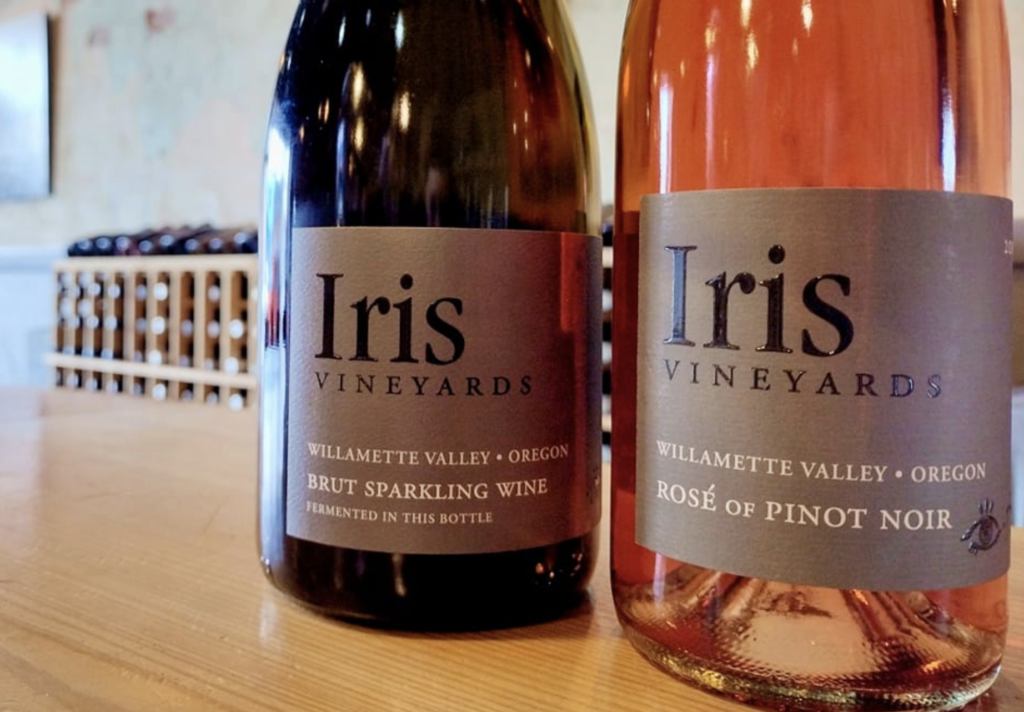
Then there’s the Brut Rose, the Pinot Noir 2021, the House Red Blend. A lot of people will remember 2020 and how that vintage went for us. I refer to that year as the worst year of my life.
Let’s talk a little bit about what made it such a bad year.
We had beautiful weather during bloom. I started to feel like it was going to be a really great vintage. We’re seeing a really modest crop load and smallish berries, which leads to more fruit forward. Right around Labor Day, the major fires started. Smoke came into the valley for about two weeks which was extremely disheartening.

In the Willamette Valley that was really our first experience with that level of damage to the fruit. So a lot of people were scrambling, worried, and ultimately didn’t produce Pinot Noir in 2020.
We made less than we had planned. We applied some techniques to mitigate the smoke effect.
Can we talk about what you did to mitigate?
Well, there are two things that helped the most. One, we sent some grapes to California to go through a process called flash. It’s a kind of thermovinification method where the must is heated to 80 degrees celsius and then pumped into a vacuum chamber that boils at a much lower temperature. The water and the skins of the grapes “flashes” to steam in the the vacuum chamber. That steam carries away a lot of bad things. Those things are responsible for the bulk of the smoke effect that you might find in a wine.

Then following vintage and some aging, we did some reverse osmosis to remove the smoke effect from the rest of our wine.
At the tail end of vintage, I had surgery for appendicitis. As I was about recovered from that, I got covid right at the end of 2020.
Fortunately ’21 and ’22 were very similar to 2020 and how the vintage started and ended up, we had some really beautiful fruit and beautiful wines. I’m really excited about ’22 based on what we have in barrel right now.
Some people approach wine from a food and wine pairing point of view. I’m not sure if you are a chef or a home cook, but do you have any suggestions for great food pairings for some of your bottles?

I think with our Pinot Gris, I really enjoy seafood.
It’s really good with salad. Brut Rose, I always say if you’re making a dinner and you’re not quite sure what wine to serve with your dinners sparkling wine is always a a crowd pleaser. It’ll go with dishes from salad to steak or pizza. The acidity of sparkling wines makes them really versatile in any kind of food. Fatty foods in particular pair well with more acidic wines, kind of a palette cleansing.

For our Pinot Noir, traditional pairings like salmon and chicken.
When you’re going through a year, from growth to harvest, what are the traits or elements that get you excited saying it’s gonna be a good year?
Last spring we had a couple of fairly severe frosts after bud break and it was an interesting year because of that. We ended up, to everyone’s surprise, with a vintage that was quite nice and yields that were not really affected by the frost. The vines bounced back with their secondary and tertiary buds set fruit, set a really good crop. We got a nice batch of wine out of it.

If we get into harvest in the rainy season, sometimes your hand is forced and the grapes start to get ripe, the skin softens an they become more susceptible to botrytis and other bad things that you don’t want.
But ’22 was nice. We weren’t really forced right up until the end. Around October 20, we had the first big rainstorm come in. 20% of our fruit still hanging. We brought most of it in before that big rain.
But I think we had really good ripeness even at that point.
You’ve been doing in-person and zoom wine tastings, do you have a favorite part of that wine tasting process?
My favorite part, without a doubt, is just when I see somebody tasting my wine and the look on their face shows me that they’re really enjoying it. That’s a big reason why I’m in this industry, what we do makes people happy.
Do you have a certain memory of including either your wine or someone else’s wine in a great celebration?
Several memories. My father and I had a wine business of our own from 2002 to 2015. [A few years in] we had a celebration at a steakhouse in Portland. I ordered a Puligny Montrachet off the menu. I still remember that wine quite vividly and how impressive it was. That changed my mind about chardonnay in some ways.
In Oregon, there’s a lot more chardonnay coming out of the Willamette Valley now is a good thing, but it’s still been an uphill battle for producers to get that chardonnay wine passed the gatekeepers, the distributors.
You go to a distributor and they’re like, “Everybody drinks California Chardonnay or white burgundy. They don’t know about Oregon Chardonnay. And when you say Willamette Valley, everybody thinks Pinot Noir, which is great. But we’ve kind of pigeonholed ourselves with that. There are a lot of other nice things that can come out of this valley like Pinot Gris and Chardonnay. So we have some work to do on the marketing and publicity to let people know.
Any lessons your winemaking team has learned this past vintage that you can share?
I think that happens every year. Let’s not assume that I know everything because I learn stuff every year as well.
One of the things that I really stress with people who are working for me during harvest, is the importance of fermentation temperature.
It’s with white wine, with aromatic whites in particular. You really have to keep the temperature under control. Yeast likes to get hot and ferment fast, so you have to keep those ferments cool, whatever the method is if you’re in stainless with jacketed tanks or if you’re in barrel and you’re taking the barrels outside at night or wetting them down to keep the temperature down. It’s super, super important.
With the white wines, you get a temperature or a fermentation that’s too hot and you end up with a wine that’s like generic white wine. It doesn’t have varietal character left in it, that’s something I stress a lot.
Then when you talk about red wines, the style of red wine that you’re making is so dependent on a lot of things, but temperature is a big thing. So if you do a cool ferment on a red wine, you’re going to have a red wine that’s fruit forward and aromatic, but it’s not going to be very extracted. It’s not gonna have a big tannic backbone to it. In that way it would be out of balance.
Like with our Willamette Valley Pinot Noir, we do a couple of different fermentation methods that end up having different peak fermentation temperatures and then we blend them together to get a wine that is crowd pleasing, easy balanced. So one of my big things is temperature.
Are there any topics in winemaking that you wish got more attention?
The fact that I don’t do this alone. If I didn’t have a team behind me doing the right thing and supporting production in the winery, starting with our vineyard and our vineyard manager, who is amazing, grows amazing fruit, all the way through to the marketing team selling the wine or promoting the wine and the sales team selling the wine. I think it’s really important for people to understand that it’s really a team effort. I’m the winemaker, I get the publicity, I get the recognition but there’s no way I could do it by myself.
I’m sure you talk to young winemakers all the time. Is there one huge piece of advice you would give a young winemaker from all your experience?
A big thing would be, and I’ve made this mistake when I was a young winemaker, if you’re about to do something to a wine and you think you know what you’re doing, but you’ve never done it before, make a phone call.
Ask another winemaker that maybe has had the experience and has done that. You’ve got a 5,000 gallon tank of wine and you’re gonna do some kind of adjustment that you’ve never done before. Get some information first.
Building network, building community, reaching out to those with either more experience or more diverse experience.
Yes. And in most wine regions, it is a community and people are happy to share their information to help the next guy out. Because ultimately, if we’re all making really good wine in the Willamette Valley, that enhances our reputation as a region. So I think it would be a big mistake for us not to share information.
Let’s talk about where people can find more information.
On Iris Vineyards website and social media. Our website is IrisVineyards.com and our handle on every social site is @IrisVineyards.
So thank you again for your time, and it was, it was great to have this conversation.
Thank you, Joe. I really appreciate your time.
Post Views: 449


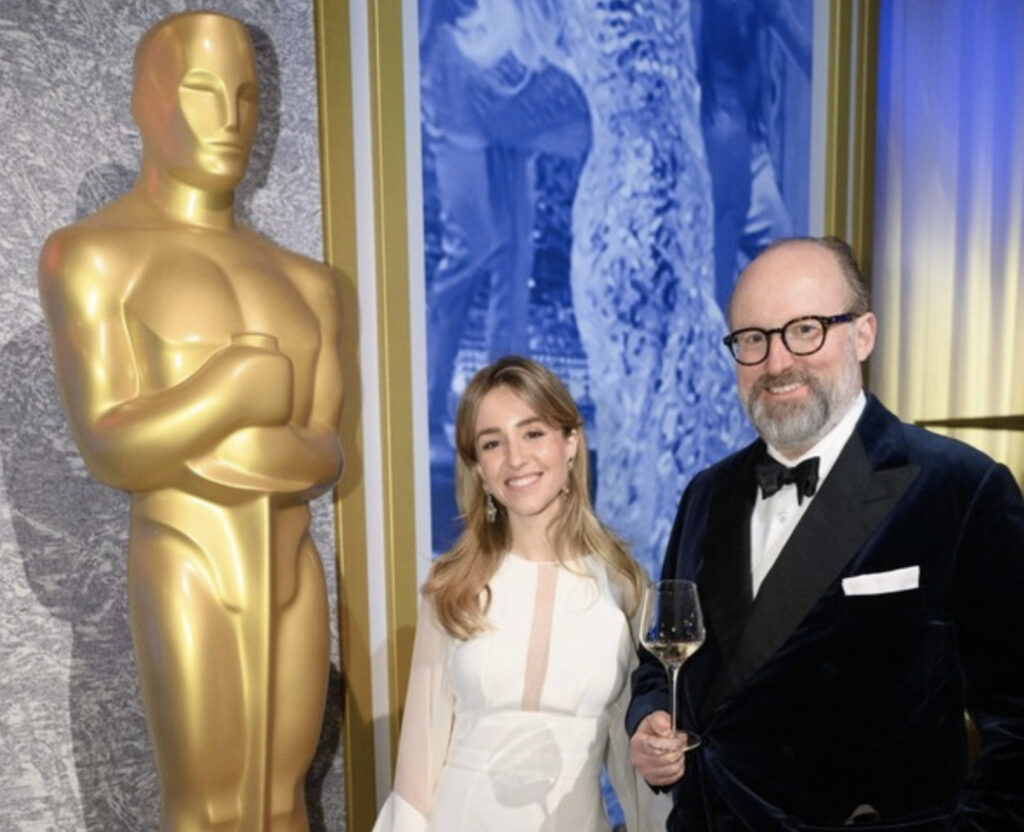
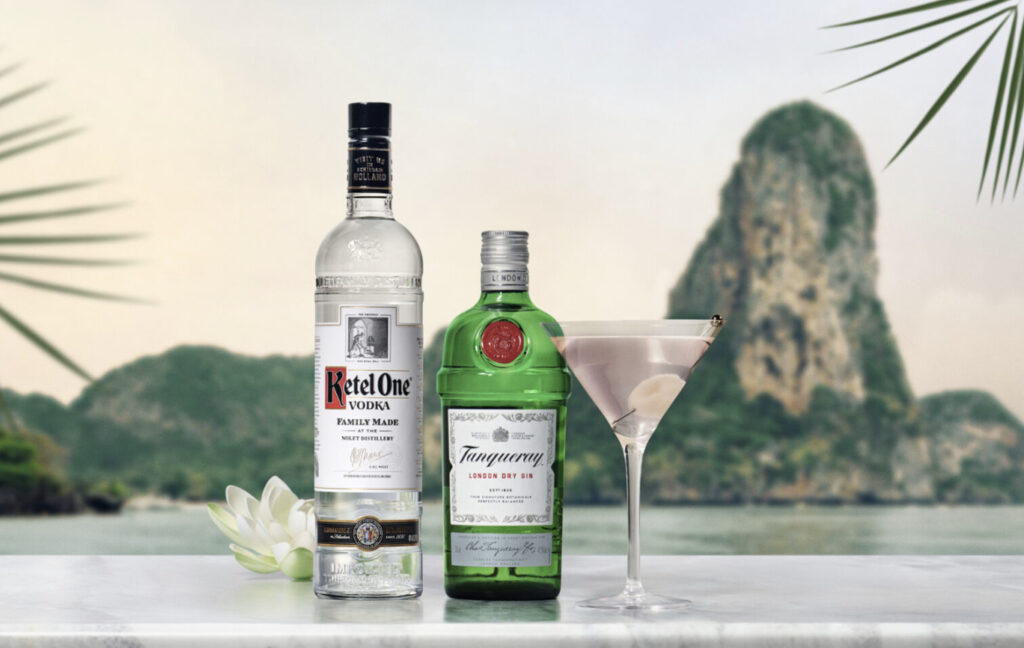
![Thanksgiving in Philly: perfect stuffing bread DOES exist – and it’s… [Find Recipe Inside]](https://philly.flavrreport.com/wp-content/uploads/2024/11/6D4A5499-1024x683.jpg)

